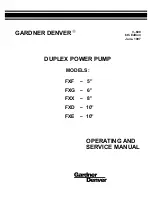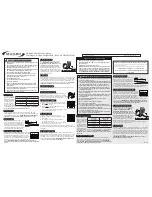
d) In case of incorrect use, fluid may escape from the battery. Avoid contact with it. If you touch it by
accident, rinse the affected area with water. If you get the fluid in your eyes, also seek medical
advice. Leaking battery fluid can cause skin irritation or burns.
e) Never use damaged or altered rechargeable batteries. Damaged or altered rechargeable batteries
can behave unpredictably and lead to a risk of fire, explosion or injury.
f) Never expose a rechargeable battery to fire or high temperatures. Fire or temperatures over 130°C
pose a risk of explosion.
g) Follow all the instructions on charging and never charge the rechargeable battery or cordless tool
outside the specified allowable charging temperature range. Incorrect charging or charging outside
the allowable charging temperature range could cause irreparable damage to the battery and
increase the risk of fire.
Additional safety instructions
We pay a great deal of attention to the design of every battery pack to ensure that we supply you
with batteries which feature maximum power density, durability and safety. The battery cells have a
wide range of safety devices. Each individual cell is initially formatted and its electrical characteris-
tic curves are recorded. These data are then used exclusively to be able to assemble the best
possible battery packs. Despite all the safety precautions, caution must always be exercised when
handling batteries. The following points must be obeyed at all times to ensure safe use.
Safe use can only be guaranteed if undamaged cells are used. Incorrect handling can cause cell
damage.
Important:
Analyses confirm that incorrect use and poor care are the main causes of the damage
caused by high performance batteries.
Information about the battery
1. The battery pack supplied with your cordless tool is not charged. The battery pack has to be
charged before you use the tool for the first time.
2. For optimum battery performance avoid low discharge cycles. Charge the battery pack frequent-
ly.
3. Store the battery pack in a cool place, ideally at 15°C and charged to at least 40%.
4. Lithium-ion batteries are subject to a natural ageing process. The battery pack must be replaced
at the latest when its capacity falls to just 80% of its capacity when new. Weakened cells in an aged
battery pack are no longer capable of meeting the high power requirements and therefore pose a
safety risk.
5. Do not throw battery packs into an open fire. There is a risk of explosion!
6. Do not ignite the battery pack or expose it to fire.
7. Do not exhaustively discharge batteries. Exhaustive discharge will damage the battery cells. The
most common cause of exhaustive discharge is lengthy storage or non-use of partly discharged
batteries. Stop working as soon as the performance of the battery falls noticeably or the electronic
protection system triggers. Place the battery pack in storage only after it has been fully charged.
8. Protect batteries and the tool from overloads. Overloads will quickly result in overheating and cell
damage inside the battery housing without this overheating actually being apparent externally.
9. Avoid damage and shocks. Replace batteries which have been dropped from a height of more
than one meter or which have been exposed to violent shocks without delay, even if the housing of
the battery pack appears to be undamaged. The battery cells inside the battery may have suffered
serious damage. In this respect, please also read the waste disposal information.
10. If the battery pack suffers overloading and overheating, the integrated protective cut off will
EN
13
hood must be slid over the blade and the rechargeable battery removed when the equipment is not
being used.
• Shrubs which loose their leaves in the autumn should be cut in June and October.
• Evergreen shrubs should be cut in April and August.
6.2.1 Assembly
Since the equipment is supplied as grass shears (see section 6.1), the grass cutting blade has to be
swapped over for the shrub cutter blade which is supplied with the product. Caution! Carry out all
the following assembly, dismantling and adjustment work without a rechargeable battery – risk of
injury. Use protective gloves and the blade guard hood which is supplied with the equipment.
1. Push the blade release buttons (Fig. 6a) on both sides and remove the blade at the same(Fig. 6b).
2. Slide the blade housing into the mount on the equipment housing.
3. Push the blade release buttons on both sides again(Fig.7) and press the blade into the mount at
the same time. The drive unit on the equipment is now connected to the blade.
4. Push the battery into the battery mount provided until you hear the catch click into position.
6.2.2 Switching on/off .
Proceed as described in section 6.1.
6. CLEANING, MAINTENANCE AND ORDERING OF SPARE PARTS
Danger! Remove the rechargeable battery!
7.1 Cleaning
• Keep all safety devices, air vents and the motor housing free of dirt and dust as far as possible.
Wipe the equipment with a clean cloth or blow it with compressed air at low pressure.
• We recommend that you clean the device immediately each time you have finished using it.
• Clean the equipment regularly with a moist cloth. Do not use cleaning agents or solvents; these
could attack the plastic parts of the equipment. Ensure that no water can seep into the device. The
ingress of water into an electric tool increases the risk of an electric shock.
• The shears should be cleaned thoroughly every time before and after use. A few drops of oil (for
example sewing machine oil) applied to the blades improve the cutting performance. However, never
apply grease to the blades.
• To guarantee a constant exact cut it is necessary that grass residues and dirt are also removed
from the top and bottom blades.
Caution!
Because of the risk of injury or damage to property, never clean the product with running water,
especially not with a pressure hose. Store the cordless shears in a dry and frost-free location. The
storage place must be inaccessible to children.
7.2 Maintenance
• For good cutting performance the blades should always be sharp. They can be therefore be resha-
rpened with a whetstone. In particular we recommend to remove notches and ridges which are
produced on the blades by stones or the like.
• There are no other parts inside the equipment which require maintenance.
7.3 Ordering replacement parts:
Please quote the following data when ordering replacement parts:
• Type of machine
• Article number of the machine





































